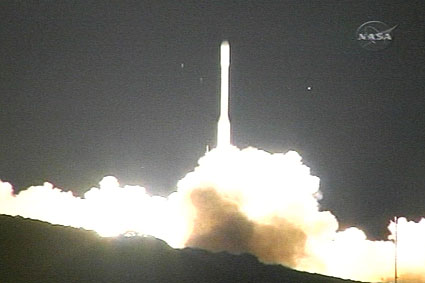The canopy of the satellite did not separate from the satellite as planned three minutes after launch and therefore it could not gain enough altitude, and crashed in the vicinity of Antarctica

NASA's orbital carbon observatory, the OCO satellite failed and failed to reach its orbit after it was launched today (Tuesday 13:55 Israel time) from Vandenberg Air Force Base in California. In a preliminary report, it was stated that the canopy of the Taurus XL launcher failed to separate from the rest of the launcher about three minutes after launch.
The canopy or nose cover is a shell-like structure that covers the satellite as it moves through the atmosphere. "The canopy has considerable weight and when it separates from the missile, a jump is felt in the acceleration of the launcher" says John Braunschweiger from Orbital Sciences, the manufacturer of the launcher. "We did not receive an indication of this jump in acceleration as a result of carrying the excess weight, and as a result of carrying the excess weight, it was not possible to reach the track. The first signs indicate that the craft did not gain enough speed to reach orbit and landed in the ocean near Antarctica.
Braunschweiger adds: "Our tzot, on a personal level, is disappointed by the event, and certainly the entire scientific community is disappointed. It took us a long time to get to this stage."
NASA and Orbital Sciences have established committees of inquiry to investigate the reasons for the failure. The company will postpone the launch of the Glory satellite planned for June 2009, until the exact cause of the system is not clarified. GLORY is also supposed to probe the Earth's atmosphere and collect data on the aerosols and carbon in the Earth's atmospheric climate system.
The development of the OCO satellite took eight years and it was supposed to study the balance of carbon dioxide, which is the main greenhouse gas in the atmosphere.
NASA's launch manager Chuck Duvall said that the countdown went without a hitch and that the canopy was meant to separate with the help of four electrical pulses that cause the rails blocking the canopy to shift. "We checked that the correct commands were sent to the spacecraft. Three minutes into the launch we watched several telemetry bits and tried to match them. When the canopy separates, electrical wires are torn that inform us that the operation has been carried out, but these wires remain intact. There are also temperature sensors, but Braunschweiger says that most of the significant data showed that there was no jump in acceleration as a result of the weight reduction that would have occurred if the canopy had separated as planned."
"OCO was a very important mission whose role was to measure important components of the carbon cycle," said Michael Freilich, director of the Earth Sciences Department at NASA. During the coming period we will examine how to continue from here and advance science given the satellites that are already in space today, satellites of other countries and the existence of space reserves that will allow us to put together a flight plan as quickly as possible and continue what OCO was supposed to provide and even advance beyond that in understanding the science of ball systems Country."

8 תגובות
They worked on this satellite for 9 years!!! It doesn't really make sense for it to have a malfunction.. I bet you that this is a conspiracy by the car companies so that they don't see how much pollution is happening as a result of this.. We will all die because of it!!!
By the way, Birch:
Once upon a time everyone used the expression "carbon dioxide" and only in recent years with the birth of the word "public" as a strange replacement for the word "public" and with a few more pseudo-Hebrew tongue twisters, the expression "carbon dioxide" also entered our language
Birch:
Yes - it is used to describe the same compound.
The truth is that I once heard a pretty convincing argument that the phrase "carbon dioxide" should not actually be used because this phrase might create the impression that it is a different type of carbon, while the phrase "carbon dioxide" might not create such a misunderstanding.
Yes
Say people, carbon dioxide is carbon dioxide (CO2)?
Come on 1 you're shut up...
I assume that the reconstruction and rebuilding of an alternative oco satellite can be done at much cheaper costs and in a relatively short time since the research and development have already been done.
So…
Everything is from heaven!!
We must delve into the study of Torah instead of engaging in nonsense.
Only from Torah will salvation come!!